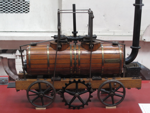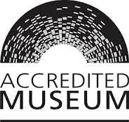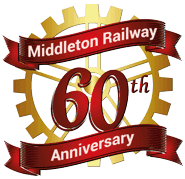General
The Passage of Time
The following was written as a reflection on the life of Queen Elizabeth II, in the days after her death on 8th September 2022.
Queen Elizabeth the Second's remarkable life of service and dedication to our country, and the enormous changes which occurred during her reign, have rightly drawn much comment in the days since her death.
It is of note that:
- the Middleton Railway has now operated during the reigns of no less than 11 monarchs, starting with King George II;
- the late Queen’s Diamond Jubilee was the second Diamond Jubilee through which the Railway has operated; and
- when our Railway received its first Act of Parliament in 1758, America was still a colony and Jane Austen was not even a twinkle in her parents' eyes.
In 1812, during the Regency, the Middleton Railway ushered in 'The Age of Steam'. Then, in 1960, the year in which President John F Kennedy was elected, the Middleton Railway became the first standard gauge Heritage Railway in the country.
The Middleton Railway has served the community of South Leeds for 264 years of the 956 years since the Norman Conquest in 1066 – an unparalleled period of continuous service.
The Middleton Railway wishes King Charles III a long and successful reign and we look forward to continuing to serve South Leeds throughout his reign and beyond.
During the period of National Mourning, our home page carried the following image in memory of the late queen's life of service to the nation.

Wagon B740883
Pipe Wagon
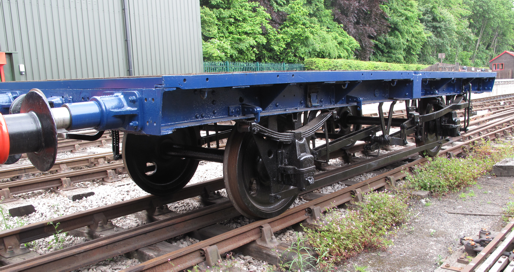
| Built | British Railways, date not known |
| Load capacity | 12 tons |
| Length over buffers | 24' 6" (approx 7.4 m) |
| Previously worked | British Railways, then Royal Naval Armaments Depots, then Llangollen Railway |
| Entered collection | Purchased from Llangollen Railway in 2020 |
| Current status | Operational, following conversion to a flat wagon |
More details of our rolling stock collection are given in our stockbook.
Go back to goods wagon B769924.
Return to the list of goods wagons.
More Information
Other pages provide more information about:
Accessibility
Moor Road Site
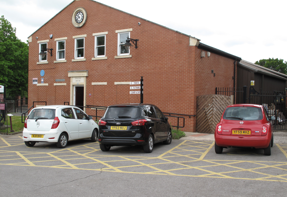
Access from the car park to the Engine House
When You arrive ...
|
|
|
|
|
|
|
|
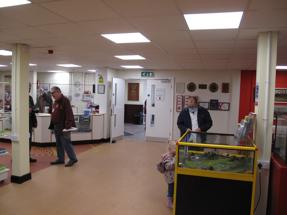
Inside the shop and cafe area
In The Engine House ...
|
|
|
|
|
|
|
|
|
|
|
|
|
|
|
|
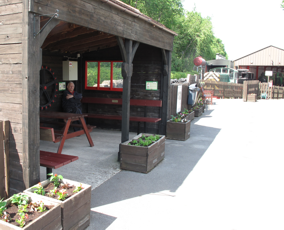
The platform and shelter
The Display Hall and Platform ...
|
|
|
|
|
|
|
|
|
|
On the Trains
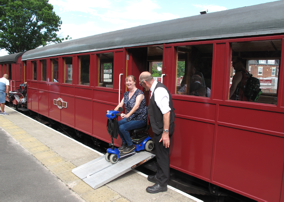
The wheelchair ramp in use
Our Passenger Coaches ...
|
|
|
|
|
|
|
|
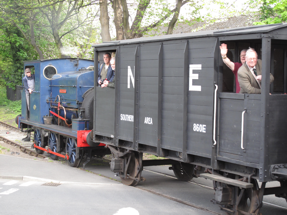
A special train, with a goods brake van.
Special Trains ...
|
|
|
|
Park Halt
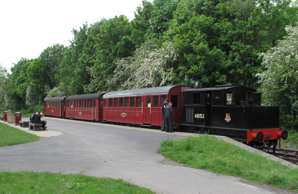
The platform at Park Halt
At Park Halt ...
|
|
|
|
|
|
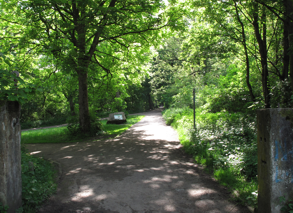
A path leading to Middleton Park
To Middleton Park ...
|
|
|
|
|
|
More Information
Other pages of our site ...
Overhaul of No. 6 Part 2
We knew that the work on the boiler of No. 6 would not be a quick job, and so once the boiler had been collected (in February 2019) we were not expecting it to be returned to us repaired until at least the end of 2019. And, of course, this was a long time before the phrase "corona virus" had become common place, and it turned out that this pandemic was to disrupt planned time scales significantly for lots of things.
Meanwhile, the other bit of the locomotive that needed overhauling was the saddle tank, and so we turned our attention to this. Once the tank had been craned down from where it had been stored, on top of a container adjacent to the car park, it did not take much inspection to identify that the back end of it was in a very poor condition. This was hardly surprising, as the back of the tank forms part of the front of the coal bunker, and coal dust is quite corrosive. Indeed, it was obvious that this part of the tank had been patched before, but a section of the patch had now rusted through.
This meant that the only realistic approach was to start by cutting the back out of the tank, so that then we could see inside properly, in order to assess the condition of the rest of it. The picture below shows the inside of the tank, viewed through the hole where the back of it had been cut out.
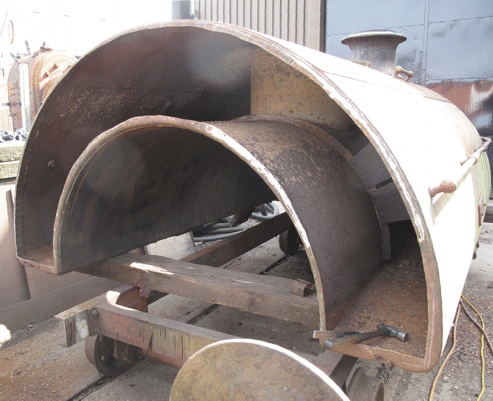
Cutting the back out of the tank needed to be done quite carefully, so as not to damage the rest of the tank. Also, the bit that was cut out had to be kept, so that it could be used as a template to make a replacement that would be exactly the right shape to be welded into place, once the rest of the tank had been overhauled. The picture below shows the piece that had been cut out, carefully labelled "Do Not Scrap", to ensure that it would be kept. The hole where it had rusted through is clearly visible.
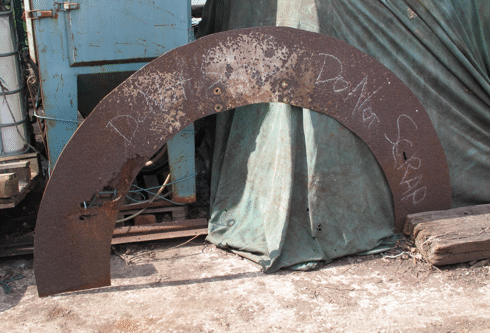
Once we could assess the condition of the inside of the tank, though, it became apparent that the rest of it was not in much better state. Indeed, repairing it properly would effectively mean building a complete new tank, rather than just welding in some new pieces of plate. Because the tank was actually of rivetted construction (even if this was not obvious to the casual observer, since the rivets had been carefully countersunk), this meant that we had to make a choice between the completely authentic option of a new rivetted tank, or the simpler and cheaper option of a welded one.
By this time (March 2019) Northern Steam Engineering had started work on the boiler, and had advised us that the top part of the smokebox (where it fits under the saddle tank) was beyond repair, and so a significant part of the smokebox was also going to need replacement. With the costs of completing the overhaul apparently mounting up, we took the decision that the replacement saddle tank should be a welded one, to reduce the cost, and so drawings were prepared and tenders obtained.
Similarly, Northern Steam Engineering were instructed to remove the old smokebox, as a prelude to them constructing a new one. This would involve a new front plate and a new wrapper plate, but fortunately the smokebox door and hinges were still in useable condition, and so they were kept, ready for fitting onto the new box once it had been built.
The picture below shows the boiler in the works at Northern Steam Engineering, with the new firebox side plate welded into place and the support angle (which sits on the main frames to carry the weight of the back of the boiler) riveted on to it. The bottom edge of the plate has been riveted into place, and it has been bolted temporarily to the backhead and throat plate, to support it while the stay holes had been drilled through.
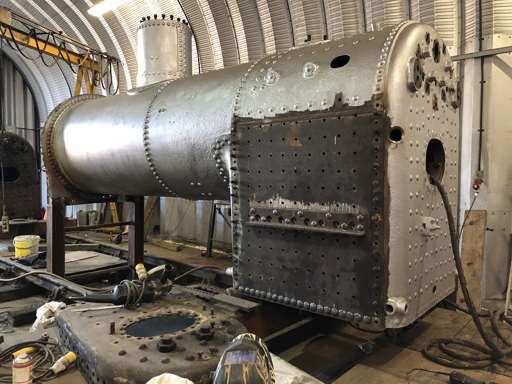
Another picture, taken on the same visit to inspect progress, shows the front of the boiler, with the old smokebox removed and some of the rivets that fasten the tubeplate to the boiler replaced. All was now ready for them to start fabricating the new smokebox.
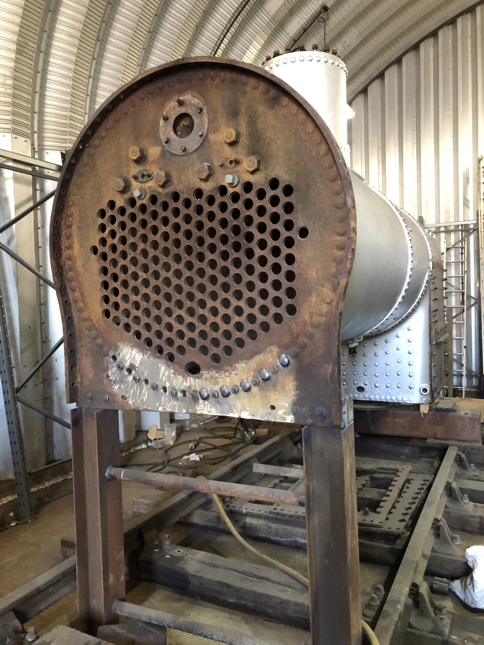
Meanwhile, the new tank had been delivered, and we had fitted to it the tank filler cap and handrail knobs (which we had salvaged from the old tank) and the handrail (which we had made new). By this time we had had the long discussion about what the final livery should be, and had agreed that it would be in the original shade of green, with black edging for the panels. So both the tank and cab had been moved into the paint shop, where they are shown in the picture below.
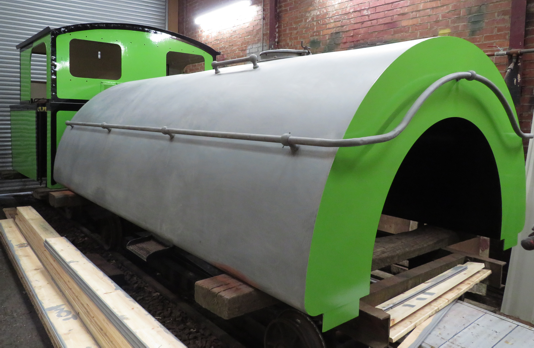
By this time the corona virus pandemic was disrupting everything, and so it was beginning to look as though we would not actually complete the overhaul during 2020. In particular, Northern Steam had initially needed to furlough their staff, until they had been able to work out a scheme to enable them to operate in a CoViD-safe manner, and then there had been significant delays in the deliveries of components such as the boiler tubes. But they had managed to solve these problems, and by the time of the next inspection visit (in June 2020, roughly a year after the first one) all the tubes had been fitted into the boiler, and the base for the new smokebox had been made and fitted, as shown in the picture below. Also, the ashpan had been checked over, to make sure that it would fit onto the bottom of the firebox, and in this picture it can be seen on a pallet underneath the boiler, newly repainted in aluminium paint.
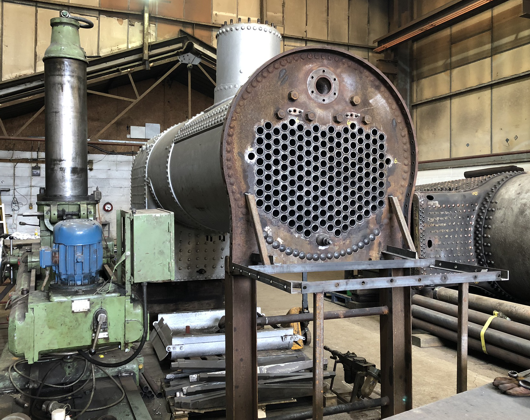
Given this progress, we were starting to look forward to the return of the boiler, but the hydraulic test of the boiler showed up two problems that would need fixing, both to do with the "J" pipe. This connects the regulator valve (which is mounted inside the dome) to the main steam pipe (which runs through to the front tubeplate, and emerges through the large round hole that is visible at the top of the tubeplate in the picture above). One of these problems was that there was a small hole in the "J" pipe itself, through which steam could leak continuously, and the other was that there were problems with the joint between the "J" pipe and the main steam pipe, so that again this would leak steam continuously.
Fixing these problems involved taking the "J" pipe out and sending it to a firm who specialise in welding cast iron components. They welded up the "J" pipe and sent it back to Northern Steam, who re-fitted it into the boiler and made a new joint onto the main steam pipe. They were then able to repeat the hydraulic boiler test satisfactorily, and follow this up by steam testing the boiler. Having passed this, it was then loaded onto a suitable lorry, along with the ashpan, and transported back to Leeds. On arrival the first step was to fit the ashpan to the bottom of the firebox, as illustrated in the picture below (which also shows the effect of the steam test on the paint on the back of the firebox).
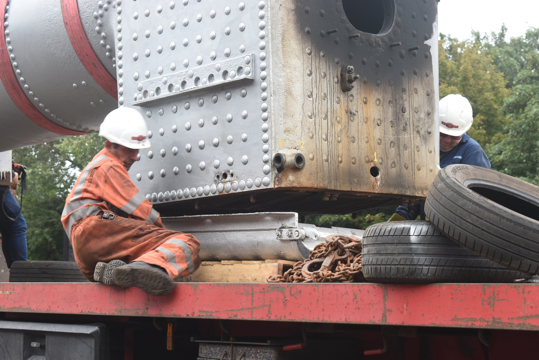
Once the ashpan had been fitted, then the hydraulic hoist on the lorry lifted the whole boiler assembly, swung it round and lowered it gently into the frames of the locomotive, as shown in the picture below. It had been an important part of the arrangements that the boiler needed to be moved by a lorry with a hoist that had sufficient capacity to do this, as the boiler assembly was too heavy for our grey crane to lift.
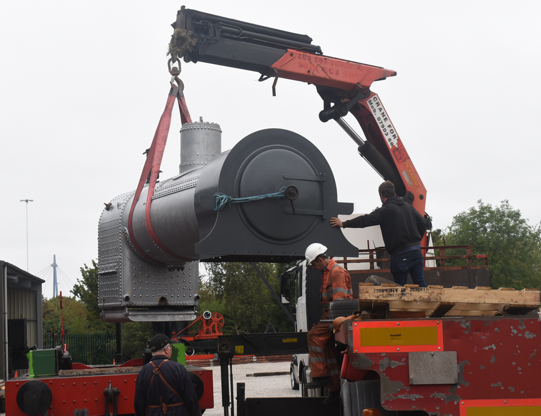
Much to our great relief, the boiler slotted nicely back into the frames, although the base of the smokebox did require a bit of persuasion with some large hammers to fit down round the top of the cylinder casting. Also, it became apparent that the new cab footplate extended just a little bit too far forward to clear the boiler drain valve, which is mounted on the back of the firebox below the fire door. So we would have to cut a slot in the front of the cab floor to clear it, and the picture below shows the preparations being made for this.
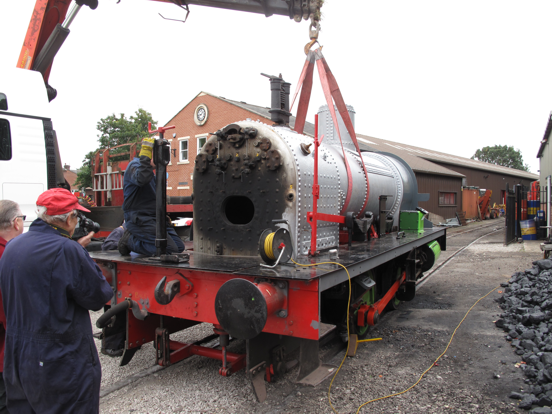
The footplate material is not particularly thick, and so it was fairly easy to cut the slot out using a small grinder fitted with a cutting disc, as shown in this picture.
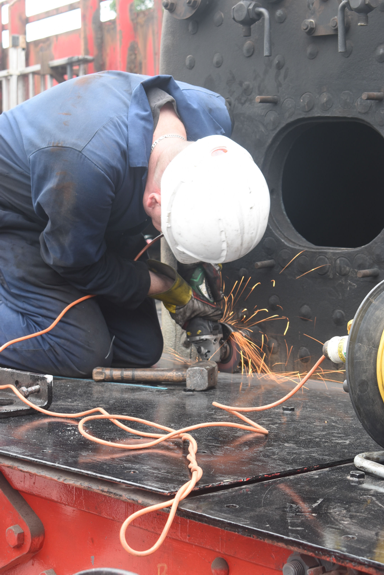
With the boiler fitted nicely into the frames, No. 6 could then be shunted back into the workshop, ready for the next steps. The Sentinel was included in the shunt so as to get the two locomotives into the most suitable order on the track in the workshop for the remaining work on each.
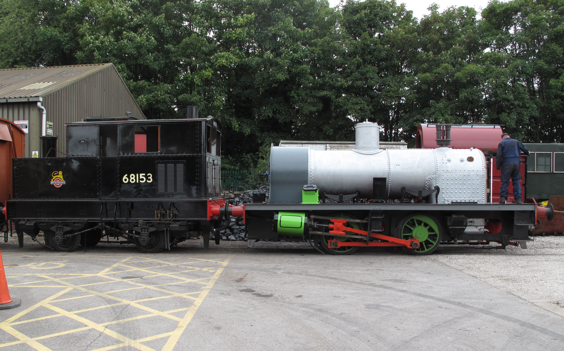
Once in the workshop, the first steps had been to fit the rockwool lagging to the boiler, and the crinoline rings that hold it in place and support the cladding sheets. Also we had needed to make a new set of firedoors, and these had been fitted to the back of the firebox, as shown in the picture below.
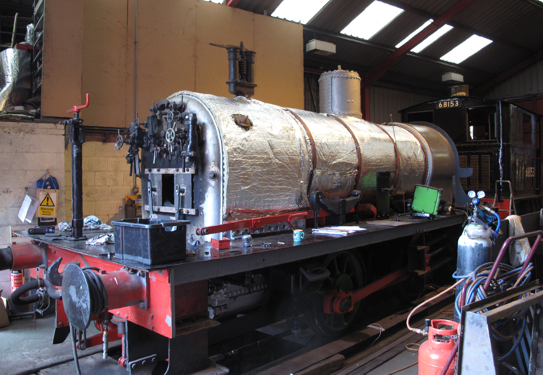
None of the original cladding sheets had been in a fit condition to be reused, so we had needed to make a complete new set. This had involved cutting each sheet out carefully to fit round features such as the dome, holding the sheets temporarily in place with webbing straps, and then finally securing them with the boiler bands, as shown in this picture. Here the lighting makes it almost impossible to tell the boiler bands from the cladding sheets, as while the firebox cladding had now had a coat of dark green undercoat, the rest were still all in red oxide primer.
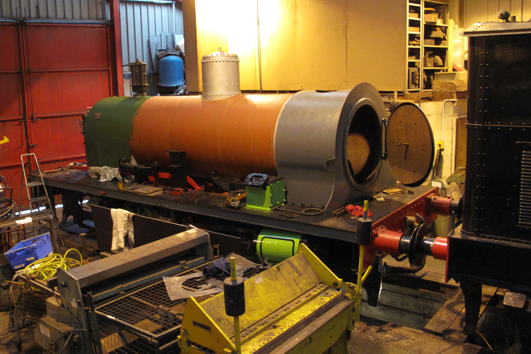
With the cladding in place, the next step was to fit the cab and the tank, so No. 6 was shunted out of the workshop to enable the crane to access it. The cab and the tank had been sitting on trolleys which had been stabled outside the workshop, behind the locomotive, and so these were rolled out through the workshop and the cab lifted off its trolley with the crane, as in the picture below.
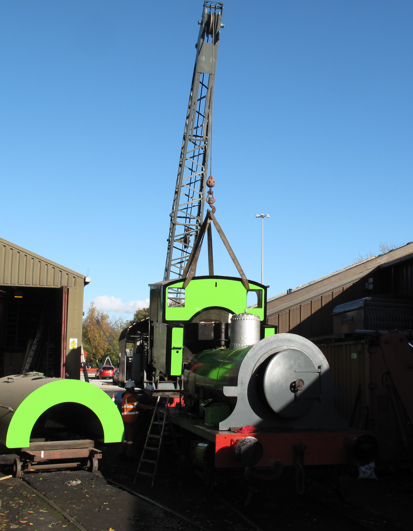
As the cab was being lowered into place, its position needed to be adjusted carefully, to ensure that all the bolt holes would line up properly with the ones in the chassis and footplates. Once this had been done, as shown in this picture, then it could be lowered the last couple of inches and bolted into place.
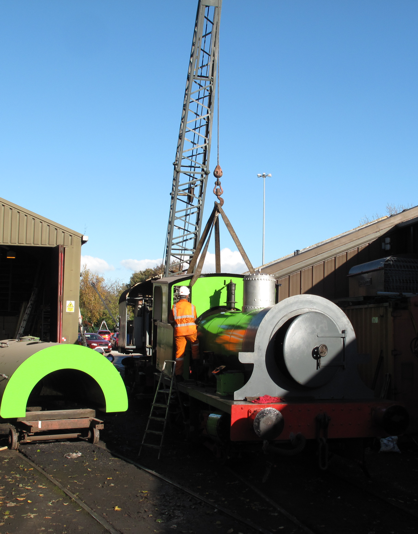
Bolting down the cab and bunker unit took some time, and once this had been done then it was the turn of the tank to be lifted off its trolley with the crane, as shown in the picture below.
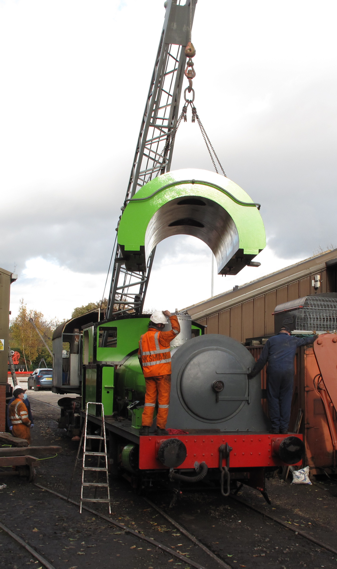
Positioning the tank was going to be a trickier job than positioning the cab, because it was a new tank, and while we had been very careful over the measurements for it we had no guarantee that it would fit as exactly as we needed. Consequently, the last foot or so of lowering the tank into position was done very carefully, checking all the points at which things might foul if dimensions were not quite right, as shown below.
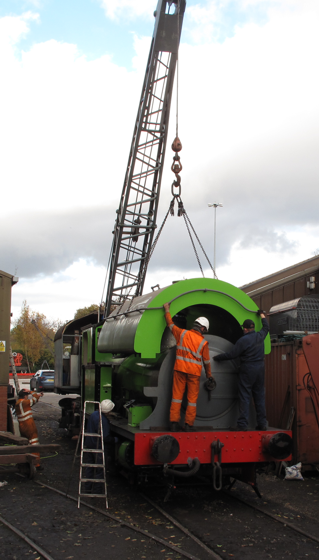
It was a great relief to everybody when the tank fitted with no apparent problems, as in this picture, so that the crane could release the weight. Then the slings could be taken off, and No. 6 was shunted back into the workshop. It was beginning to look like a locomotive at last!
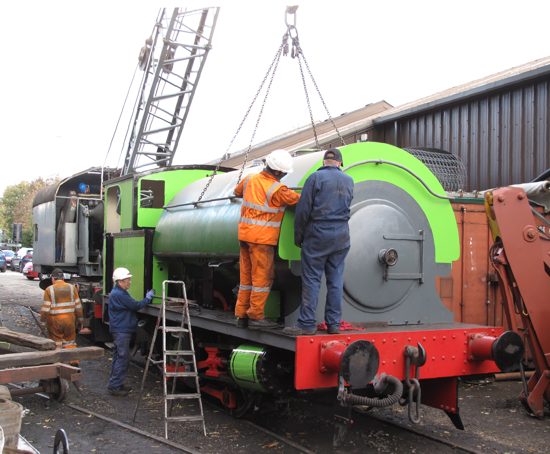
The next step was to start fitting the pipework to the tank, but this did identify a problem, in that the balance pipe which goes underneath the boiler fouled on the front sandboxes. So the tank had to be taken off again, the fittings for the balance pipe moved back an inch or two so that they did not foul, and then the tank replaced. The picture below shows the locomotive back in the workshop, with the balance pipe (painted black) now fitted.
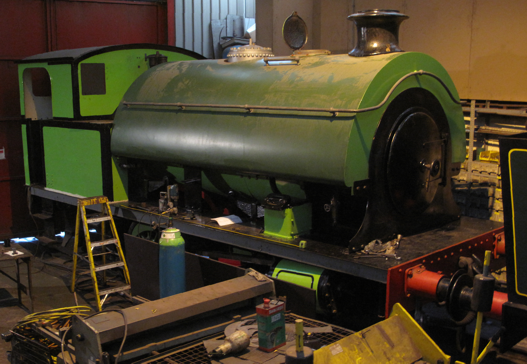
By this time it was clear that the overhaul would not be completed during 2020, as there was still a lot of work to do, and only a few weeks of the year left in which to do it. The chimney had been aligned with the blastpipe and fitted, but the dome cover still had to be fitted, as did all the remaining pipework, and the associated valves and other fittings. Also the tank needed to be given its final coats of paint. But once these were done, it was time to steam test the locomotive, and the picture below shows it under test outside the workshop.
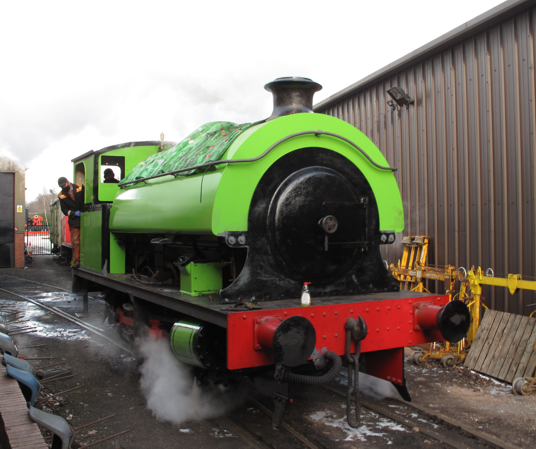
After a lot of careful checking, it was time for it to move, at least as far as the coaling stage. Once some coal had been taken on, then the dustsheets that had been covering the tank were taken off and it was shunted back a bit for some photographs to mark the occasion, such as the one below.
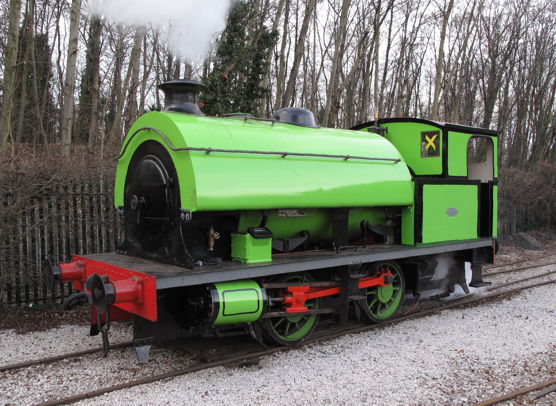
This of course was not the end of the story, as there were still details to sort out, such as the bunker wing plates which extend up behind the tank and alongside the firebox. Also, the lining out of the tank and the cab still needs to be completed, including fitting the works plates. But we confidently hope that it will be ready for service for the start of the 2021 operating season.
Go back to the main page for this project.
Go to the page "Help Raise Steam in No. 6", which describes the appeal for funds that we had set up to help finish this project.
More Information
Pages about other projects:
- Last Coals to Leeds;
- Project Phoenix;
- Building a Running Shed;
- Overhauling "Brookes No. 1";
- Conserving "Picton".
Other pages provide more information about:
Train Services FAQs
Yes, on any day when the railway is open and operating trains, but provided that neither you nor anyone who would be visiting with you is experiencing any symptoms of CoViD-19 infection.
For details of our operating days please follow this link.
The safety of our volunteers and visitors is our top priority, and in particular two measures are still in place.
- There are sanitising stations at entry points and other strategic locations; and
- there are till screens at the Moor Road station.
We strongly ask that you please do not visit the railway if you are experiencing any symptoms that might be Covid-19.
Yes, the shop and café at Moor Road are open on any day when trains are running.
Yes, the toilets at Moor Road are open on any day when trains are running.
Please note that there are no toilets on the train or at Park Halt. We believe that the toilets in the Middleton Park Visitor Centre may be open, but we are not certain.
Yes, our free car park is operating normally.
In general advance booking is not required for our train services, and so is not available.
For special services, such as our Santa trains, the information in other pages here will make it clear if advance booking is either available or required.
Yes, we are able to take party bookings. See this page for more details.
Yes, we can accommodate single travellers as well as parties, and our fares are essentially per person.
Yes, concessionary tickets are available.
See this page for more details.
Yes, two of our coaches have wide doorways specially to allow access for wheelchairs.
See this page for more details.
Yes, you are welcome to do this (except for the Santa Special trains). But do make sure that you do not miss the last train back from Park Halt to Moor Road.
Yes, for trains other than the Santa Specials you are welcome to do this.
Yes, we are dog friendly at the Middleton Railway and they travel free of charge. We kindly ask that your dog stays on a lead at all times and does not sit on the carriage seats.
The only exception to this is the Santa Special trains, where we can only accommodate assistance dogs.
Yes, certainly – particularly if you are going to get off the train at Middleton Park, where there are plenty of good picnic spots. We kindly ask that you either dispose of your rubbish in one of our bins, or take it home with you, to help us maintain cleanliness around the railway.
Please contact
More Information
Other pages provide more information about:
- Our museum collection;
- Our portfolio of development projects;
- How you could get involved;
- What we offer for visitors;
- Our train services;
- How to find us.
Subcategories
Projects
Projects and appeals.
Volunteering
For pages related to volunteering and membership

